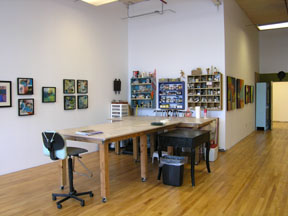I love reading what artists have to say about making their work - especially what they say to themselves in their notebooks, sketchbooks, diaries, etc. In The Art of Richard Diebenkorn, John Elderfield includes in his essay (pp 112-113) a list that Phyllis Diebenkorn found in her husband's papers after his death. The undated list was written some time between 1966 and 1976 and headed, "Notes to myself on beginning a painting." This is what it said:
1) Attempt what is not certain. Certainty may or may not come later. It may be a valuable delusion.
2) The pretty, initial position which falls short of completeness is not to be valued - except as a stimulus for further moves.
3) Do search. But in order to find other than what is searched for.
4) Use and respond to the initial fresh qualities but consider them absolutely expendable.
5) Don't "discover" a subject - of any kind.
6) Somehow don't be bored - but if you must, use it in action. Use its destructive potential.
7) Mistakes can't be erased but they can move you from your present position.
8) Keep thinking about Polyanna.
9) Tolerate chaos.
10) Be careful only in a perverse way.
Elderfield, who knew Diebenkorn for a period of years and visited him in his studio many times, also says that "his argument with himself was continuous." His greatest battle was to attain a "reconciliation" between the initial idea for a painting and finishing it while not relinquishing the inspiration. Elderfield describes the process in a very turgid way, but I think what he means is that RD (as we all do) wanted to retain the excitement and freshness that an idea for a painting arouses and not kill it as he went along. RD said, "I can never accomplish what I want, only what I would have wanted had I thought of it beforehand."
Now, here's the part that reminds me of my favorite teacher at MassArt - Rob Moore* - Elderfield says that RD would "contrive things so that he would see a painting when he was 'completely off guard', forgetful of his participation in its ongoing history in the hope of the surprise that would tell him that he had re-established contact with his spontaneity." What Rob Moore said, and what I also say in my artist's statement is that seeing what is there (in a painting) instead of what you think is there is the hardest part of painting.
What connects these two observations about painting is the difficulty that the artist has in seeing his/her work as it exists and not as a record of its history or as the sum of many parts. Some artists keep mirrors in their studios and look at their work through them. I remember George Nick at MassArt saying that he sometimes put a completed painting behind his TV so that while watching TV, his eye would sometimes stray to the painting and he would be able to get a look at what was really there. I tried this in my early days of painting and it did help. Now that we have digital images of our work and can see it on a monitor, we get another perspective, but jpegs don't have the physicality of the real thing and the screen illumination makes it a different experience.
I guess the only thing that works for me is hanging up a painting in the studio after I think it's finished and then living with it for a while. I have to move on to something else and get to the point that I'm not actively looking at the painting and then maybe I can really see it. Sometimes this leads to futzing with it and other times I let it stay as it is. It's all a question of time - but we've all got plenty of that.
*Rob Moore died in 1992, before the online age so there's nothing to link him to. I have a wonderful review by Christine Temin in the Boston Globe of the retrospective of Rob Moore's work that MassArt mounted in 1993. I'll write up some excerpts from it along with some of my own observations.
Wednesday, January 14, 2009
Subscribe to:
Post Comments (Atom)








1 comment:
This post is particularly helpful to me. A long time admirer of RD, I had never seen these comments, so I'm grateful to you for sharing them. It is comforting to know that such a lion could still have to remind himself of what is essential to resolve a good beginning into a mature yet fresh completion.
This summer I took a workshop for the first time in many years, and have been recharged by the entire experience. Bonney Goldstein was the instructor, and she suggested that to "really see" a painting in process, one should turn away from it, then take a very quick glance at it. What "pops out" is what needs to be resolved. And I still use the "Will Barnet test." In an article in Art News a few years ago, he said a painting wasn't done until he came upon it suddenly and had the "wow factor," (I forget his exact words, but you know what I mean.)
Thanks!
Post a Comment